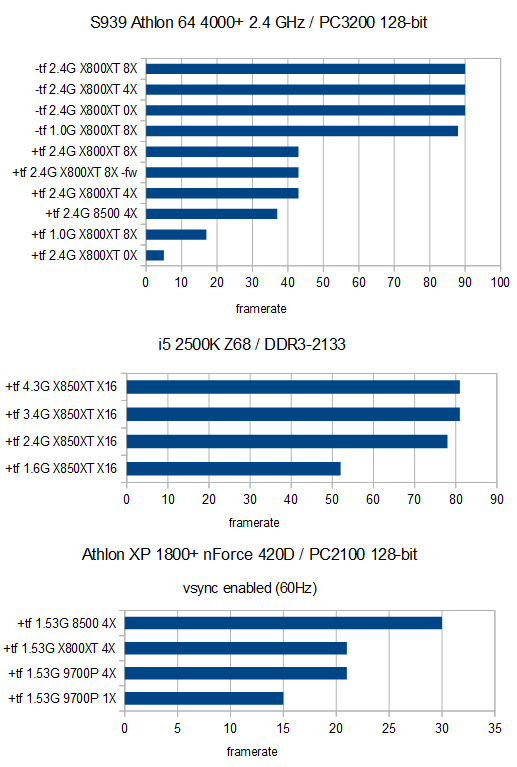First post, by swaaye
I've been playing a bit of Return to Castle Wolfenstein lately, on Radeon 8500. Switched to Radeon 9700 Pro and saw the frame rate drop badly in some cases. I was playing on a Athlon XP 1800+ with AGP 4x at the time. For those who aren't aware, the Radeon 8500/9100 R200 chip is the only GPU with full Truform processing. The later chips do it at least partially in software and the speed hit can be tremendous, depending on how many models in view are being tessellated. I don't recall anyone testing it.
I found a scene with a number of tessellated NPC models, which causes a major speed hit on the 9700. I collected frame rate numbers across 3 platforms with 4 different GPUs.
-the same install of RTCW was used for all systems
-set to High Quality 1600x1200x32
-varied CPU speed with RMClock and Throttlestop
-Catalyst 5.8 on Windows XP SP3
(fw = AGP fastwrites, tf = truform)
AGP 0x (PCI mode), 1x, 4x, 8x and PCIe x16 tested.

Thoughts:
One needs a rather fast CPU and a speedy bus to avoid a bottleneck with software Truform. The Core i5 2500K machine appears to max it out at a bit more than 2.4 GHz.
AGP 4x appears to be sufficient bus bandwidth, at least for the Athlon 64, but any less than that becomes a bottleneck. Software Truform apparently sends much more data to the GPU. From what I understand, Truform tessellation can be seen as a form of compression, as a way to avoid added bus transfer of more geometric data and you lose this when it runs on the CPU.
Also interesting is I noticed the Radeon 8500 appears to tessellate slightly more than the software TruForm by default. I suppose they reduced the tessellation factor to prevent the performance from being even worse.


